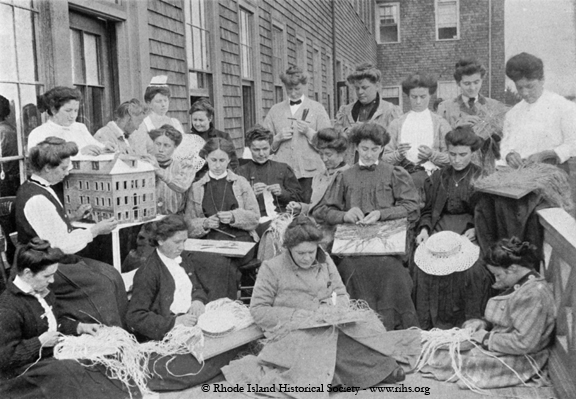 Our January presentation in the Library’s display case gives us a glimpse at the important features in our state’s efforts against tuberculosis.
Our January presentation in the Library’s display case gives us a glimpse at the important features in our state’s efforts against tuberculosis.
In the 1890’s this nation began organizing to research, prevent and treat tuberculosis. Rhode Islandwas at the forefront of this movement. In 1896 the state almshouse at Howard, RI began treating tuberculosis patients. In North Scituate the Pine Ridge Camp opened in 1904 and had a capacity for 30 patients. The St. Joseph’s Hospital annex in Hillsgrove opened in 1905 and helped mainly the incurable cases. A “seaside hospital” for children with tuberculosis was established in 1907 in East Greenwich as a branch ofRhode IslandHospital.
Experience in other parts of the nation showed the advantages of open-air treatment for the early stages of the disease. Separating these patients from the rest of the population would minimize the spread of tuberculosis. The state then considered the feasibility of building and maintaining a state sanatorium. A sanatorium was built in the northwest corner of the state, on 250 acres of land, at Wallum Lake. It opened in 1905. The superintendent was Dr. Harry Lee Barnes. Under his direction the sanatorium gave patients access to fresh air along with a regular schedule, good food and medical attention. Initially the sanatorium was overwhelmed with prospective patients. In 1909, Barnes refused admission for 181 patients because their disease was too far advanced. Over 200 patients needed hospital care. Still, Barnes was criticized for admitting too many patients and for not always allowing the examining physician to have the final decision concerning the admittance of potential patients. Barnes is also noted for refusing to allow men and women patients to mingle.
The care offered by the sanatorium was likely one of the factors that led to a decrease in Rhode Island’s death rate from tuberculosis. It fell from 198.5 in 1907 to 131.3 in 1920.
A hospital to treat advanced cases of tuberculosis was established on theWallumLakeproperty in 1917. In the 1930’s they added a nurses home, two other buildings for staff and also the Wallum Lake House, which included a kitchen, bakery, auditorium, chapel and pharmacy. Until 1936 the sanatorium also had a vegetable garden, hennery and piggery. These were constructed by patients and employees. By 1940 the original buildings were destroyed, mainly because they were considered a fire hazard. In the 1940’s the superintendent was Ubaldo E. Zambarano. Today the hospital is named after him.
Tuberculosis is caused by exposure to tubercle bacilli bacteria. There is often a six month incubation period before symptoms appear. Individuals can become infected through exposure to infected sputum or other expectorants. In the early twentieth century, another possible cause, especially among infants and children, was consuming contaminated milk. Rhode Island adopted a law requiring that each county have a commissioner to investigate animals thought to be infected, and to quarantine these animals for examination. In 1920 it was noted that five of seven samples of “baby’s milk” collected in Providence were contaminated with tubercle bacilli and that not more than 60 per cent of the Providence milk supply was pasteurized.
Rhode Island was noted for its well-organized programs to prevent and treat tuberculosis. The state board of health kept a register of all reported cases. The prevention of tuberculosis also involved educating the public. To this end, the Rhode Island Anti-Tuberculosis Association was formed in 1907. The Providence Tuberculosis League formed in 1920. The league tried to help indigent patients to be transferred to the sanatorium. It also held clinics, provided skin tests for children, cared for children at the Lakeside Preventorium, etc. In 1922 there were also 21 local tuberculosis associations in the state.
There were various attempts to find effective surgical and medical treatments for tuberculosis; most had little success.
Charles V. Chapin was the Superintendent of Health for the city of Providence from 1884 to 1932. He made significant contributions in the prevention and treatment of tuberculosis. He urged that local health officers should distribute circulars to every family. The circulars would explain how to prevent the spread of tuberculosis from one family member to another. Chapin also made recommendations for disposal of the sputum of tuberculosis patients, recommendations for control of infected milk, and other recommendations. He also urged that the families of patients should keep careful records. Health records would give more knowledge of the susceptibility of family members, knowledge of incubation periods, and would help assess the effectiveness of preventive measures that had been used.
The display case includes photographs taken at the state sanatorium, the document that certified the Providence Tuberculosis League in 1920, promotional literature for the League’s sale of Christmas seals in 1925, and a portrait of Charles V. Chapin. The display will be on view through Friday, February 3, 2012. The Library is open Wednesday-Friday,and the second Saturday of every month, from 10 AM to 5 PM.
~ Peter Griswold, Assistant Technical Services Librarian

A “seaside hospital” for children with tuberculosis was established in 1907 in East Greenwich as a branch ofRhode IslandHospital.
The “seaside hospital” mentioned above is a large brick Second Empire mansion that was actually built in North Kingstown in 1872 and used as a summer house until it was turned over to the hospital. The north end of NK had an EG mailing address until the 1950’s, so I am assuming that’s why your story indicates that the site is located in East Greenwich. The gorgeous French Mansard structure is now used by the priests as part of the Scalabrini Nursing Home site on North Quidnessett Road, adjacent to Quidnessett Country Club, with its historic carriage house still in existence, as well. The Friends of the North Kingstown Free Library sponsored a bus tour two years ago of the Quidnessett area of NK and this mansion site was one of the places we visited.